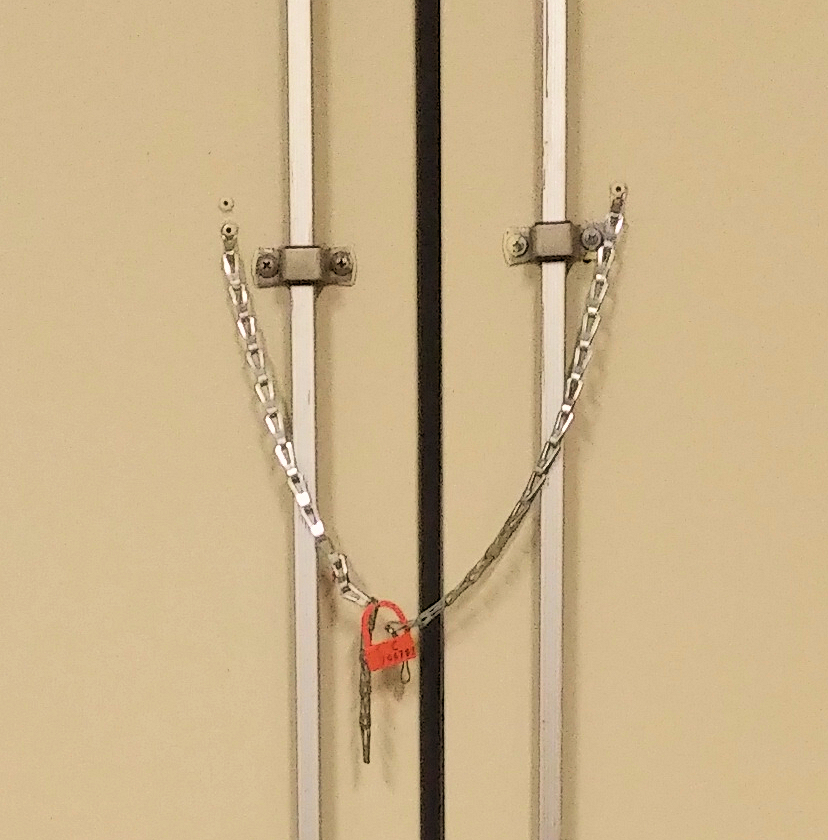The intent of the application in today’s Fixed-it Friday photos is obviously to deter the use of the doors – do you think this is code-compliant? Have you ever seen any documentation on these plastic loops? It’s kind of interesting that the doors have delayed egress locks but they still need the chain as a deterrent.
Thank you to Christopher Cleaver of the University of Dallas for today’s Fixed-it Friday photos, which were taken at an antique shop in Texas.
You need to login or register to bookmark/favorite this content.







Have not tested the plastic zips, but I have not seen any high security ones used.
They look about the same grade as fire extinguisher zips. I am not sure if the fire extinguisher ones, have any specific requirements?????
To me it is just for staff to be able to document, no one has opened the doors, since last check.
Well, if that’s the tamper evident seal I think it is there’s an easy bypass for it. It’s one of the less reliable ways to know that the door hasn’t been opened. There are variations that come with a breakaway strength, but I’m not going to be that it’s below the ADA push strength. I’d vote non-compliant for ADA, IBC and NFPA.
They could get similar behavior with adhesive tamper evident stickers that are cheaper, easily compliant and harder to bypass, but why would they want that?
I was under the impression there can be NO means of locking, be it mechanical or otherwise, what if by chance the chains became entangled to each other, or hooked in another fashion, or causes the slide to become entangled in it, if there is a large rush through the door for an emergency, you could be looking at a potential bad situation.
I am not advocating this solution, but wouldn’t this be compliant as long as the force to open the door is less than what is required by code?
I agree. It is a tamper seal. Is it compliant???
It would not affect the operation of the door.
Hi Rick –
These are not specifically addressed in the model codes (at least not for doors), so it would depend on AHJ interpretation.
– Lori
They are security strips. They have serial numbers on them so they can check every day to make sure no one has used that opening. They break with very little force.
If the delayed egress maglocks are used as intended and functioning properly, the built-in DPS and MBS features would indicate remotely as to whether the doors were actually opened (unauthorized egress) or not, so why the silly zip chain or whatever the heck it’s termed?
The plastic locking device will break with almost no effort and is an obvious sign that the door has not been opened as long as it is intact. I can see it going either way depending on the AHJ but it would appear to not be a problem. On the other hand, the solid bar below the exit device that has a higher surface profile than the device is a problem and is not compliant. Definitely wrong there.
Just looks like a visual reminder that these doors are not to be used every day. However to the uninformed this could be confusing and therefore I would not allow it on my site
I think a “security seal” such as shown would apparently require a cutting tool to defeat and be non -code compliant. I believe this application would demand the type of seal used on fire extinguishers which are easily broken by hand:
https://www.directindustry.com/prod/caplugs/product-11859-1308415.html
If these were fire rated doors I feel like it would void the warranty.
Also the additional push bar is not code complaint
Appears there is a standard for fire extinguisher tamper zips::::
Pull pin fire extinguisher seal is made from durable polypropylene which secures the trigger, yet brFire extinguisher seal meets UL specs 12-14-lb. test.They can also be used to seal supply cabinets, totes, and more.Breaks away upon activation.
What about those cross bars below the 99 exits? If they are projecting out further than push pad could impede the use of the actual exit device.
Hi Brenda –
There isn’t anything in the model codes specific to the stationary push bar…I’ve had a couple of posts on similar applications and it is left up to AHJ interpretation (for now).
– Lori